
FIRE FOCUS ❘ By Michael M. Dugan
On July 8, 2018, a report of fire was received for the 1400 block of E. 67th St. in Chicago, Illinois. The weather was warm with a high temperature in the upper 80s, and members of the Chicago (IL) Fire Department had to deal with debilitating heat and humidity. Units responding saw a large column of smoke in the area, indicating they might be going to work. The firehouse was only a couple of blocks away, and units pulled up knowing they had a working fire. Because of the response pattern, they got a view of only the front of the fire building on arrival. It was three-story attached row-type housing of ordinary construction with brick and wood. The building also had an enclosed wooden porch on the rear.
The first-arriving battalion chief approached the building from the opposite side of the first-arriving units; he stopped to get a look at the rear. Since the fire was in possession of all three floors of the rear porch, he struck a 2-11 alarm for fire at this time.
RELATED
Chicago Firefighters Rescue Tree Trimmer Stuck in Tree
Chicago Firefighters Respond to Major Factory Fire
Wind Gusts Complicate Operations for Crews at Chicago Fire
The fire originated in the rear porch area and, because of the wooden ordinary construction, the fire was an outside-to-inside-the-structure type of fire. Windows were open because of the weather, resulting in an easy migration of fire from the rear porch to all floors of the home. When this happens, the second means of egress for the occupants—the rear porch—becomes untenable.
Units made an initial push into the building through the front doors. Personnel stretched lines and conducted searches. Unfortunately, they found a toddler in a second-floor bedroom who did not survive. Search was a difficult and arduous task to complete on all three floors of this building because of the amount of fire involvement, and crews had to withdraw after completing searches.
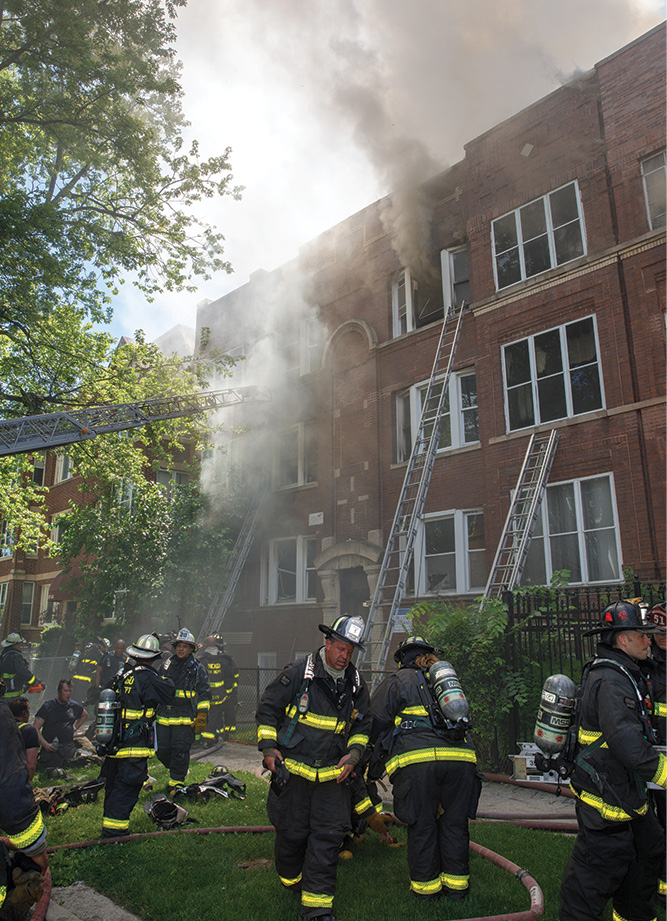
(1) The front of the building as members are beginning offensive operations at an attached row type of private dwelling. (Photos by Gordon J. Nord Jr.)
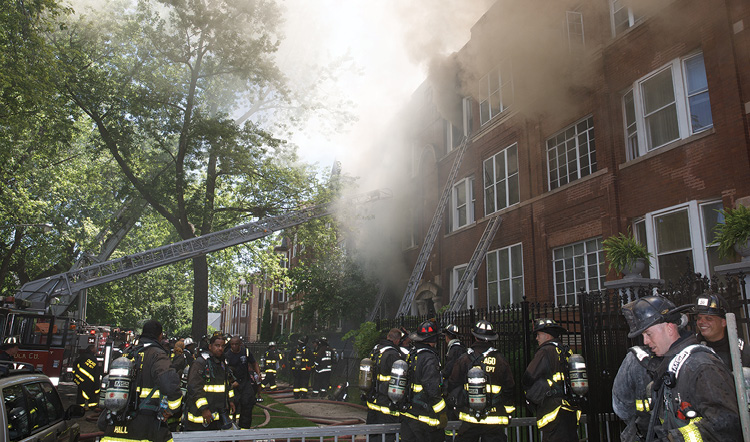
(2) On the front of the building, members placed portable ladders to the fire building and are now placing portable ladders to the top floor of the exposures on both sides. This will be a means for the members inside to evacuate in an emergency.
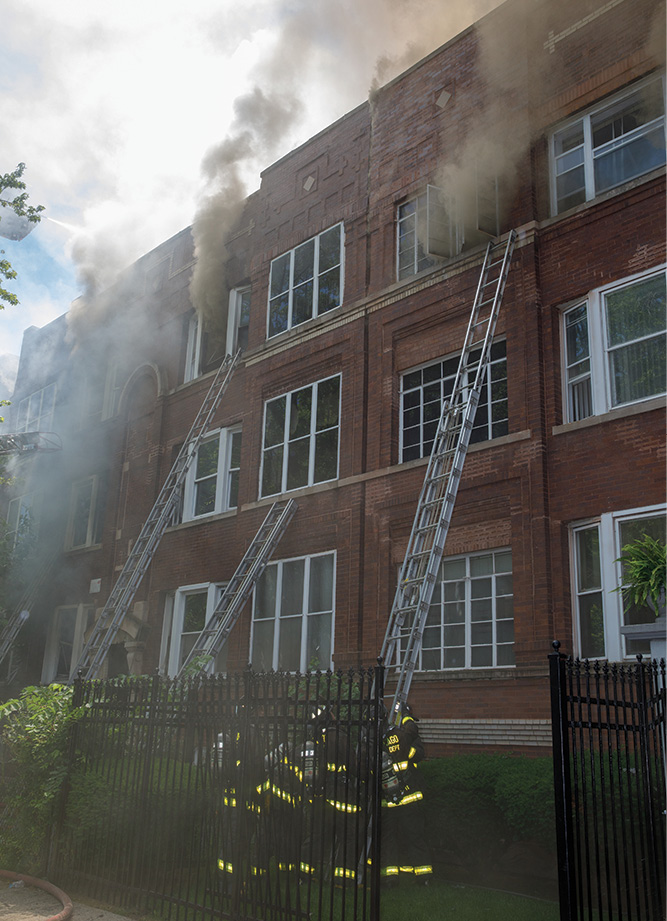
(3) As members raise a portable ladder to a window on the top floor of the exposure, we can see the smoke conditions in that window. Because of this, we need a truck company and an engine company on the top floor of both exposures.
The row-type building made it extremely difficult for units to get to the rear. In such cases, you are going to need handlines in the rear for firefighting and exposure protection.
Elevated platforms were used to extinguish some of the fire on the front of the building where apparatus access was not an issue. This was not the case in the rear yard, which was used for private vehicle parking for residents. Also, the overhead power lines that fed these units came in through the rear yards. So, wires were a cause for concern for apparatus placement and members operating handlines. A fence with a gate with a substantial top also precluded apparatus access to the space. Therefore, members had to hand-stretch hoselines to the rear of the building and operate from the exterior to extinguish the fire.
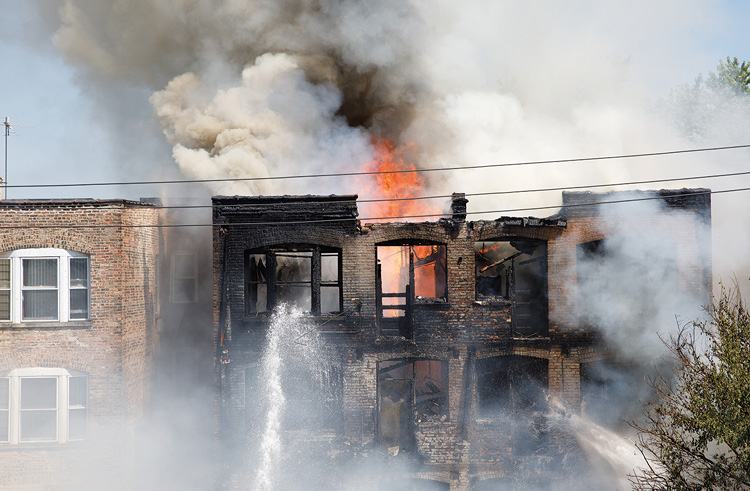
(4) As the fire intensifies, we can see in the center of the photo that a rear porch has collapsed into the rear yard. Members are operating handlines from the rear yard because of the inability to get a master stream in the rear yard.

(5) The chief assigned to the rear withdrew members for the back out of the collapse zone. Handlines are now operated from beyond the collapse zone from a flanking position.
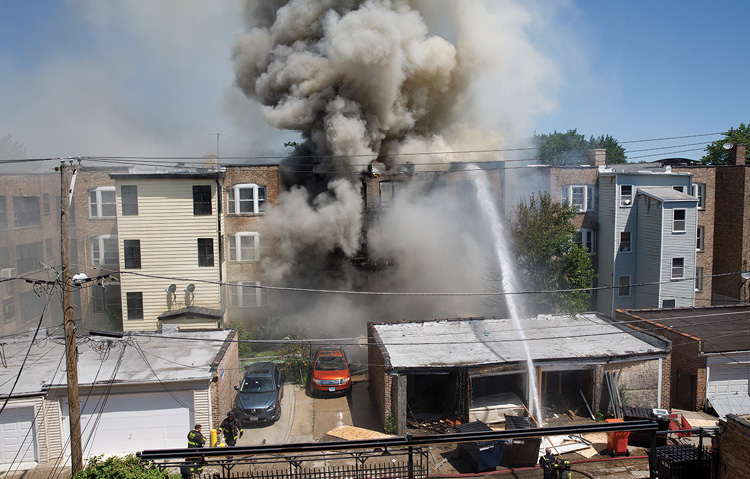
(6) Members are now operating a 21⁄2-inch hoseline over the roof of the one-story detached garage. This is going to be a prolonged operation, and relief is going to be required.
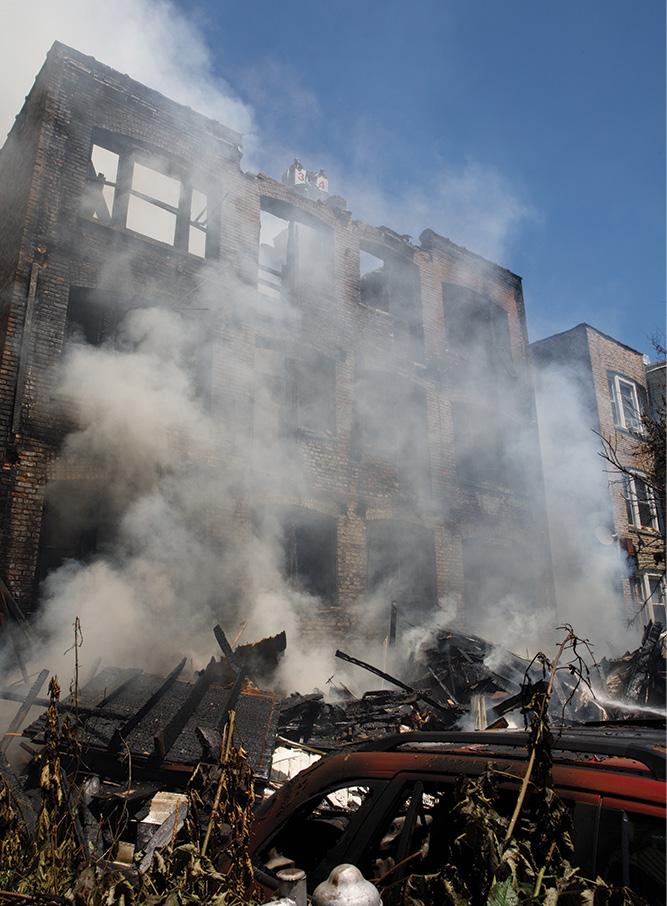
(7) We can see the amount of debris that has accumulated in the rear yard. Because of the nature of this type of construction, with a wooden rear porch, identifying the collapse zone is vital for the safety of all operating personnel.
Because the building was an attached structure, the exposures on both sides were an issue, and crews had to enter exposures and pull ceilings to make sure the fire was not spreading. This required personnel and more units. In addition to units operating in the fire building and the exposures, personnel needed relief for rehab and rehydration from wearing full bunker gear in the heat.
This type of fire is difficult! Because of the nature of the building’s construction and the rapid fire spread into the structure, the fire involvement was significant. Members made an incredible effort to get inside and make the rescue, even though the child did not survive. It was a tough job, but members did a fantastic job holding the fire to the original fire building.
MICHAEL M. DUGAN, a 42-year veteran of the fire service, is also a 27-year member of the Fire Department of New York (FDNY), where he retired as the captain of Ladder Company 123 in Crown Heights, Brooklyn. As a lieutenant, he served in Ladder Company 42 in the South Bronx and was a firefighter on Ladder 43. He is a member of the FDIC International and Fire Engineering advisory boards.

